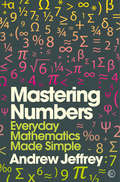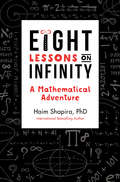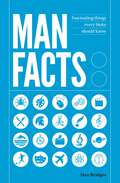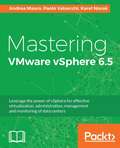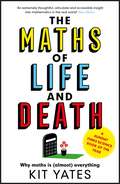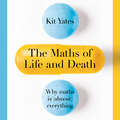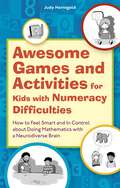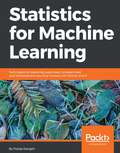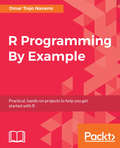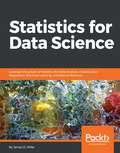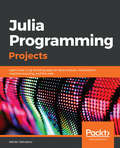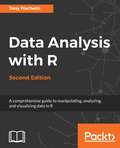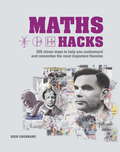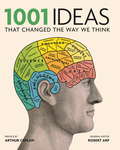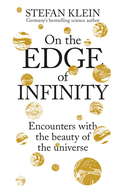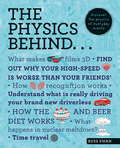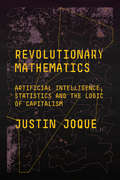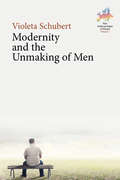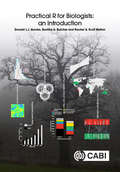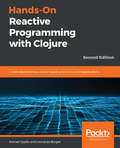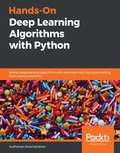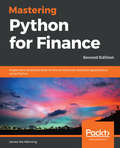- Table View
- List View
Mastering Numbers: Everyday Mathematics Made Simple
by Andrew JeffreyThe perfect antidote to numbers-phobia, this clear, concise guide explains everything you need to know about arithmetic, fractions, statistics, probability, algebra and geometry.We all use numbers every day, yet many people are uncomfortable with them, finding them daunting and difficult. Others treat numbers as a practical tool they can handle quite well, while failing to appreciate their most amazing qualities.This book is the antidote to number-phobia. As with learning to swim, youʼll never look back: these are skills youʼll use for the rest of your life. If you think youʼre good with numbers already, youʼll soon discover what youʼve been missing: the endless fascination and beauty of numbers, and – at the more practical level – a whole range of techniques and shortcuts you never knew existed.Mastering Numbers brings the subject to life, replacing the atmosphere of the classroom with the wonder of the magicianʼs workshop. In learning to enjoy numbers, we discover a multitude of practical skills – everything from understanding statistics and the odds gamblers face to the interest rates on savings and ways to maximise your returns. Never again need you flounder in a business meeting or an encounter with your bank manager – and if the chance arises to chat to him more casually, you could impress with stories about pi, prime numbers, Fermatʼs theorem, and much else besides.Full of enjoyable exercises, puzzles, demonstrations and self-testing interludes, this is a book to instruct and give pleasure.
Eight Lessons on Infinity: A Mathematical Adventure
by Haim ShapiraA fun, non-technical and wonderfully engaging guide to that most powerful and mysterious of mathematical concepts: infinity.in this book, best-selling author and mathematician Haim Shapira presents an introduction to mathematical theories which deal with the most beautiful concept ever invented by humankind: infinity.In this book, best-selling author and mathematician Haim Shapira presents an introduction to mathematical theories which deal with the most beautiful concept ever invented by humankind: infinity.Written in clear, simple language and aimed at a lay audience, this book also offers some strategies that will allow readers to try their ability at solving truly fascinating mathematical problems. Infinity is a deeply counter-intuitive concept that has inspired many great thinkers. In this book we will meet many sages, both familiar and unfamiliar: Zeno and Pythagoras, Georg Cantor and Bertrand Russell, Sofia Kovalevskaya and Emmy Noether, al-Khwarizmi and Euclid, Sophie Germain and Srinivasa Ramanujan.The world of infinity is inhabited by many paradoxes, and so is this book: Zeno paradoxes, Hilbert's "Infinity Hotel", Achilles and the gods paradox, the paradox of heaven and hell, the Ross-Littlewood paradox involving tennis balls, the Galileo paradox and many more.Aimed at the curious but non-technical reader, this book refrains from using any fearsome mathematical symbols. It uses only the most basic operations of mathematics: adding, subtracting, multiplication, division, powers and roots – that is all. But that doesn’t mean that a bit of deep thinking won’t be necessary and rewarding. Writing with humour and lightness of touch, Haim Shapira banishes the chalky pallor of the schoolroom and offers instead a truly thrilling intellectual journey.Fasten your seatbelt – we are going to Infinity, and beyond!
Man Facts: Fascinating Things Every Bloke Should Know
by Dan BridgesIt’s time to celebrate your inner geek with this treasure trove of lists and prime cuts of knowledge. Ranging across history, science and the natural world, taking in sport, film, food and much more, Man Facts gives you a wealth of up-to-date stats and eye-opening trivia that will make you a general-knowledge genius. Dig in.
Man Facts: Fascinating Things Every Bloke Should Know
by Dan BridgesIt’s time to celebrate your inner geek with this treasure trove of lists and prime cuts of knowledge. Ranging across history, science and the natural world, taking in sport, film, food and much more, Man Facts gives you a wealth of up-to-date stats and eye-opening trivia that will make you a general-knowledge genius. Dig in.
Mastering VMware vSphere 6.5: Leverage The Power Of Vsphere For Effective Virtualization, Administration, Management And Monitoring Of Data Centers
by Andrea Mauro<P><P>Deliver great business value by adopting the virtualization platform VMware vSphere 6.5, from design to deployment <P><P>Key Features <P><P>This new edition is based on vSphere 6.5 and covers new features in different areas, including management, security, scalability, availability and more <P><P>Design, deploy and manage VMware datacenters <P><P>Implement monitoring and security of VMware workloads with ease <P><P>Book Description <P><P>VMware vSphere 6.5 provides a powerful, flexible and secure foundation for next generation applications which helps you create effective digital transformation. This book is based on VMware vSphere 6.5 which empowers you to virtualize complex applications with ease. <P><P>You'll begin by getting an overview of all the products, solutions and features of the vSphere 6.5 suite, comparing any changes with previous releases. Next, you'll design and plan a virtualization infrastructure to drive planning and performance analysis. Following this, you'll proceed with workflow and installation of components. New network trends are also covered which will help you in optimally designing the vSphere environment. You will also learn the practices and procedures involved in configuring and managing virtual machines in a vSphere infrastructure. With vSphere 6.5, you'll make use of significantly more powerful capabilities for patching, upgrading, and managing the configuration of the virtual environment. Next we'll focus on specific availability and resiliency solutions in vSphere. <P><P>Towards the end of the book you'll discover how to save your configuration, data and workload from your virtual infrastructure. By the end of the book you'll have learnt about VMware vSphere 6.5 right from design through to deployment and management. <P><P>What you will learn <P><P>Get a deep understanding of vSphere 6.5 functionalities <P><P>Design and plan a virtualization environment based on vSphere 6.5 <P><P>Manage and administer a vSphere 6.5 environment and resources <P><P>Get tips for the VCP6DCV and VCIX6DCV exams (along with use of the vSphere 6 documentation) <P><P>Implement different migration techniques to move your workload across different environments <P><P>Save your configuration, data and workload from your virtual infrastructure <P><P>Who This Book Is For <P><P>If you're an administrator, infrastructure engineer, IT architect, or an IT consultant and analyst who already has basic knowledge of VMware vSphere and now want to master it, then this book is for you.
The Maths of Life and Death
by Kit Yates*SELECTED AS ONE OF THE SUNDAY TIMES SCIENCE BOOKS OF THE YEAR* "This is an exquisitely interesting book. It's a deeply serious one too and, for those like me who have little maths, it's delightfully readable" - IAN MCEWAN"An exciting new voice in the world of science communication" - MARCUS DU SAUTOY"An extremely thoughtful, articulate and accessible insight into mathematics in the real world" - ALEX BELLOS"Kit Yates is a brilliant explainer and storyteller" - STEVEN STROGATZ__________Maths is the story of the world around us, and the wisdom it gives us can be the difference between success and disaster.We are all doing maths all the time, from the way we communicate with each other to the way we travel, from how we work to how we relax. Many of us are aware of this. But few of us really appreciate the full power of maths - the extent to which its influence is not only in every office and every home, but also in every courtroom and hospital ward.In this eye-opening and extraordinary book, Yates explores the true stories of life-changing events in which the application - or misapplication - of mathematics has played a critical role: patients crippled by faulty genes and entrepreneurs bankrupted by faulty algorithms; innocent victims of miscarriages of justice and the unwitting victims of software glitches. We follow stories of investors who have lost fortunes and parents who have lost children, all because of mathematical misunderstandings.Along the way, Yates arms us with simple mathematical rules and tools that can help us make better decisions in our increasingly quantitative society. You will discover why it's always sensible to question a statistic, often vital to ask for a second opinion and sometimes surprisingly handy to stick to the 37% rule...
The Maths of Life and Death
by Kit YatesMaths is the story of the world around us, and the wisdom it gives us can be the difference between success and disaster.We are all doing maths all the time, from the way we communicate with each other to the way we travel, from how we work to how we relax. Many of us are aware of this. But few of us really appreciate the full power of maths - the extent to which its influence is not only in every office and every home, but also in every courtroom and hospital ward.In this eye-opening and extraordinary book, Yates explores the true stories of life-changing events in which the application - or misapplication - of mathematics has played a critical role: patients crippled by faulty genes and entrepreneurs bankrupted by faulty algorithms; innocent victims of miscarriages of justice and the unwitting victims of software glitches. We follow stories of investors who have lost fortunes and parents who have lost children, all because of mathematical misunderstandings.Along the way, Yates arms us with simple mathematical rules and tools that can help us make better decisions in our increasingly quantitative society. You will discover why it's always sensible to question a statistic, often vital to ask for a second opinion and sometimes surprisingly handy to stick to the 37% rule...(P)2019 Quercus Editions Limited
Awesome Games and Activities for Kids with Numeracy Difficulties: How to Feel Smart and In Control about Doing Mathematics with a Neurodiverse Brain
by Judy HornigoldHas maths ever made you feel anxious, confused or like you just don't get it? This is an entertaining collection of mathematical games and curiosities for you to astound your family and friends with. You don't have to follow the chapters in a certain order - you can use this book however you would like, whether you want to get creative, play a game or impress your friends with a clever trick.Designed to spark a child's enthusiasm for maths and make learning simple, this book will help children to grasp the fundamental concepts in maths through exploration and play. This book will appeal to all learning styles and abilities but is particularly relevant for those with specific learning difficulties such as dyscalculia. Building self-esteem and promoting a growth mindset, these activities will help readers to effortlessly develop their number skills, empowering even the least confident learner with a deeper understanding of maths.
Statistics for Machine Learning
by Pratap DangetiBuild Machine Learning models with a sound statistical understanding. About This Book • Learn about the statistics behind powerful predictive models with p-value, ANOVA, and F- statistics. • Implement statistical computations programmatically for supervised and unsupervised learning through K-means clustering. • Master the statistical aspect of Machine Learning with the help of this example-rich guide to R and Python. Who This Book Is For This book is intended for developers with little to no background in statistics, who want to implement Machine Learning in their systems. Some programming knowledge in R or Python will be useful. What You Will Learn • Understand the Statistical and Machine Learning fundamentals necessary to build models • Understand the major differences and parallels between the statistical way and the Machine Learning way to solve problems • Learn how to prepare data and feed models by using the appropriate Machine Learning algorithms from the more-than-adequate R and Python packages • Analyze the results and tune the model appropriately to your own predictive goals • Understand the concepts of required statistics for Machine Learning • Introduce yourself to necessary fundamentals required for building supervised & unsupervised deep learning models • Learn reinforcement learning and its application in the field of artificial intelligence domain In Detail Complex statistics in Machine Learning worry a lot of developers. Knowing statistics helps you build strong Machine Learning models that are optimized for a given problem statement. This book will teach you all it takes to perform complex statistical computations required for Machine Learning. You will gain information on statistics behind supervised learning, unsupervised learning, reinforcement learning, and more. Understand the real-world examples that discuss the statistical side of Machine Learning and familiarize yourself with it. You will also design programs for performing tasks such as model, parameter fitting, regression, classification, density collection, and more. By the end of the book, you will have mastered the required statistics for Machine Learning and will be able to apply your new skills to any sort of industry problem. Style and approach This practical, step-by-step guide will give you an understanding of the Statistical and Machine Learning fundamentals you'll need to build models.
R Programming By Example: Practical, hands-on projects to help you get started with R
by Omar Trejo Peter C. FigliozziKey Features Get a firm hold on the fundamentals of R through practical hands-on examples Get started with good R programming fundamentals for data science Exploit the different libraries of R to build interesting applications in R Book Description R is a high-level statistical language and is widely used among statisticians and data miners to develop analytical applications. Often, data analysis people with great analytical skills lack solid programming knowledge and are unfamiliar with the correct ways to use R. Based on the version 3.4, this book will help you develop strong fundamentals when working with R by taking you through a series of full representative examples, giving you a holistic view of R. We begin with the basic installation and configuration of the R environment. As you progress through the exercises, you'll become thoroughly acquainted with R's features and its packages. With this book, you will learn about the basic concepts of R programming, work efficiently with graphs, create publication-ready and interactive 3D graphs, and gain a better understanding of the data at hand. The detailed step-by-step instructions will enable you to get a clean set of data, produce good visualizations, and create reports for the results. It also teaches you various methods to perform code profiling and performance enhancement with good programming practices, delegation, and parallelization. By the end of this book, you will know how to efficiently work with data, create quality visualizations and reports, and develop code that is modular, expressive, and maintainable. What you will learn Discover techniques to leverage R’s features, and work with packages Perform a descriptive analysis and work with statistical models using R Work efficiently with objects without using loops Create diverse visualizations to gain better understanding of the data Understand ways to produce good visualizations and create reports for the results Read and write data from relational databases and REST APIs, both packaged and unpackaged Improve performance by writing better code, delegating that code to a more efficient programming language, or making it parallel
Statistics for Data Science
by James D. MillerGet your statistics basics right before diving into the world of data science About This Book • No need to take a degree in statistics, read this book and get a strong statistics base for data science and real-world programs; • Implement statistics in data science tasks such as data cleaning, mining, and analysis • Learn all about probability, statistics, numerical computations, and more with the help of R programs Who This Book Is For This book is intended for those developers who are willing to enter the field of data science and are looking for concise information of statistics with the help of insightful programs and simple explanation. Some basic hands on R will be useful. What You Will Learn • Analyze the transition from a data developer to a data scientist mindset • Get acquainted with the R programs and the logic used for statistical computations • Understand mathematical concepts such as variance, standard deviation, probability, matrix calculations, and more • Learn to implement statistics in data science tasks such as data cleaning, mining, and analysis • Learn the statistical techniques required to perform tasks such as linear regression, regularization, model assessment, boosting, SVMs, and working with neural networks • Get comfortable with performing various statistical computations for data science programmatically In Detail Data science is an ever-evolving field, which is growing in popularity at an exponential rate. Data science includes techniques and theories extracted from the fields of statistics; computer science, and, most importantly, machine learning, databases, data visualization, and so on. This book takes you through an entire journey of statistics, from knowing very little to becoming comfortable in using various statistical methods for data science tasks. It starts off with simple statistics and then move on to statistical methods that are used in data science algorithms. The R programs for statistical computation are clearly explained along with logic. You will come across various mathematical concepts, such as variance, standard deviation, probability, matrix calculations, and more. You will learn only what is required to implement statistics in data science tasks such as data cleaning, mining, and analysis. You will learn the statistical techniques required to perform tasks such as linear regression, regularization, model assessment, boosting, SVMs, and working with neural networks. By the end of the book, you will be comfortable with performing various statistical computations for data science programmatically. Style and approach Step by step comprehensive guide with real world examples
Julia Programming Projects: Learn Julia 1.x by building apps for data analysis, visualization, machine learning, and the web
by Adrian SalceanuA step-by-step guide that demonstrates how to build simple-to-advanced applications through examples in Julia Lang 1.x using modern tools Key Features Work with powerful open-source libraries for data wrangling, analysis, and visualization Develop full-featured, full-stack web applications Learn to perform supervised and unsupervised machine learning and time series analysis with Julia Book Description Julia is a new programming language that offers a unique combination of performance and productivity. Its powerful features, friendly syntax, and speed are attracting a growing number of adopters from Python, R, and Matlab, effectively raising the bar for modern general and scientific computing. After six years in the making, Julia has reached version 1.0. Now is the perfect time to learn it, due to its large-scale adoption across a wide range of domains, including fintech, biotech, education, and AI. Beginning with an introduction to the language, Julia Programming Projects goes on to illustrate how to analyze the Iris dataset using DataFrames. You will explore functions and the type system, methods, and multiple dispatch while building a web scraper and a web app. Next, you'll delve into machine learning, where you'll build a books recommender system. You will also see how to apply unsupervised machine learning to perform clustering on the San Francisco business database. After metaprogramming, the final chapters will discuss dates and time, time series analysis, visualization, and forecasting. We'll close with package development, documenting, testing and benchmarking. By the end of the book, you will have gained the practical knowledge to build real-world applications in Julia. What you will learn Leverage Julia's strengths, its top packages, and main IDE options Analyze and manipulate datasets using Julia and DataFrames Write complex code while building real-life Julia applications Develop and run a web app using Julia and the HTTP package Build a recommender system using supervised machine learning Perform exploratory data analysis Apply unsupervised machine learning algorithms Perform time series data analysis, visualization, and forecasting Who this book is for Data scientists, statisticians, business analysts, and developers who are interested in learning how to use Julia to crunch numbers, analyze data and build apps will find this book useful. A basic knowledge of programming is assumed.
Data Analysis with R, Second Edition: A Comprehensive Guide To Manipulating, Analyzing, And Visualizing Data In R, 2nd Edition
by Tony FischettiR has spread deep into the private sector and can be found in the production pipelines at some of the most advanced and successful enterprises. Starting with the basics of R and statistical reasoning, this book dives into advanced predictive analytics, showing how to apply those techniques to real-world data though with real-world examples.
Maths Hacks (Hacks)
by Richard CochraneEverything you need to know about 100 key mathematical concepts condensed into easy-to-understand sound bites designed to stick in your memory and give you an instant grasp of the concept.On each topic, you'll start with a helicopter overview of the subject, which will give you an introduction to the idea and some context surrounding it. Next, you'll zoom in on the core elements of the theory, with clear explanation of each point to make sure you really understand the concept, along with simple examples that everyone can follow. Finally, you'll be given a one-liner hack to really make the theory stick in your mind. The perfect introduction to algebra, logic, probability and much more, this is a great new way to learn about the most important mathematical ideas and concepts in a way that makes them easy to recall even months after reading the book.Topics covered include:NumbersAlgebraLogicGeometryProbabilityComputer scienceApplied mathematicsMechanicsStatisticsSet Theory
Maths Hacks
by Richard CochraneEverything you need to know about 100 key mathematical concepts condensed into easy-to-understand sound bites designed to stick in your memory and give you an instant grasp of the concept.On each topic, you'll start with a helicopter overview of the subject, which will give you an introduction to the idea and some context surrounding it. Next, you'll zoom in on the core elements of the theory, with clear explanation of each point to make sure you really understand the concept, along with simple examples that everyone can follow. Finally, you'll be given a one-liner hack to really make the theory stick in your mind. The perfect introduction to algebra, logic, probability and much more, this is a great new way to learn about the most important mathematical ideas and concepts in a way that makes them easy to recall even months after reading the book.Topics covered include:NumbersAlgebraLogicGeometryProbabilityComputer scienceApplied mathematicsMechanicsStatisticsSet Theory
1001 Ideas that Changed the Way We Think (1001)
by Robert ArpAn awe-inspiring overview of the development of human knowledge over the centuries!Part of the highly successful '1001' series which have sold over a million copies in the UK alone 1001 Ideas That Changed The Way We Think offers not only a comprehensive history of ideas, but also an eminently browsable source of amusement.This richly informative and entertaining book provides a wide variety of answers to those eternal questions such as...How was the universe created and what is the place of humans within it? How should a person live? And how can we build a just society?Readers will discover how the Greek philosopher Zeno 'proved' a flying arrow never moves and the mathematical proof of the existence of life in other galaxies. The inspiring ideas explored range from Gandhi's theory of civil disobedience to Mary Wollstonecraft's groundbreaking advocacy of women's rights. A wide variety of cultural movements are also covered, including Neoclassicism, Surrealism and Postmodernism.Drawing of a wide spectrum of topics including politics, cosmology, the arts, philosophy and religious beliefs, 1001 Ideas That Changed The Way We Thinktraces the exponential growth of human knowledge across the centuries. Ranging from the ancient wisdom of Confucius and Plato, to the cutting-edge theories taking shape in the twenty-first century, this book offers a wealth of stimulation and wit for any reader with a lively and curious mind.
On the Edge of Infinity: Encounters with the Beauty of the Universe
by Stefan KleinFrom the award-winning, bestselling German science author Stefan Klein An original way into the most thought-provoking scientific theories and ideas, On The Edge of Infinity is the perfect read for those curious about the workings of the universe.*How can a hurricane can reveal the world's unpredictability?How can a greying beard might demonstrate the irreversibility of time?How do the exploits of burglars in New York and London demonstrate how everything can be in two places at once?Employing stories about simple everyday items or occurrences as analogies to illuminate counterintuitive realities behind the visible world, On The Edge of Infinity reveals the astonishing beauty of the universe. This book transforms a simple everyday thing such as a rose blossom, or a day of stormy weather, into a key to understanding the most complex ideas and theories in 21st century physics. Stefan Klein unpicks the complexities and intricacies of physics, from the answered questions to the dark corners of what we have yet to discover, making this an accessible read to those with no previous knowledge of the subject.
The Physics Behind... (The Behind... series)
by Russ SwanCan you really lose weight by consuming nothing but ice cream and beer? How does the latest blockbuster movie get squeezed onto a disk, and how do they make the pictures seem 3D? How much does a selfie weigh? What's the science behind forensic investigations, body scans, and the dating of ancient artefacts?The Physics Behind... takes the reader on a fascinating journey through the scientific principles that that make the modern world work. Could there be life on Mars? Why is north really south? How do self-driving cars find their way around? These and many more topics are explored by starting with the basic science that makes them tick - examining the physics behind them. Packed with detailed original artwork and infographics, The Physics Behind... is perfect for anyone who has ever been curious about the science of life.Including:- The physics behind modern life: Wi-Fi, Facial recognition, touchscreens, microwave ovens, the ice cream and beer diet, taking a selfie, Flash memory, a bag of sugar, catching the train, calendars and clocks- The physics behind entertainment: optical discs, lasers, white water, executive toys, the electric guitar, music, 3D movies- The physics behind analysis: medical imaging, looking at little things, spectroscopy, crime scene investigation, tricorder, microfluidics, radiocarbon dating, proving the Earth is round- The physics behind space: rocket science, space weather, Planet Nine, space telescopes, is there anybody out there? life on Earth, life on Mars- The physics behind big science: what's the matter?, time travel, bomb or meltdown?, the Large Hadron Collider, the Human Genome Project, the Standard Model, gravity, everything- The physics behind the weird universe: strings, rings and other things, N-dimensional space, the hypercube, antimatter, the dark universe, quantum weirdness, quantum biology, time crystals and Majorana- The physics behind the environment: weather forecasts, climate change, renewable energy, migration, peacock feathers, sunburn, rainbows, spider silk- The physics behind transportation: autonomous autos, Hyperloop, Maglev, satellite navigation, motor sport, going rreeaallllyy fast, stealth- The physics behind everything else: curve balls, the Mpemba Effect, why north is really south, perpetual motion and the heat death of the universe, and the physics behind this book.
The Physics Behind...: Discover The Physics Of Everyday Life
by Russ SwanCan you really lose weight by consuming nothing but ice cream and beer? How does the latest blockbuster movie get squeezed onto a disk, and how do they make the pictures seem 3D? How much does a selfie weigh? What's the science behind forensic investigations, body scans, and the dating of ancient artefacts?The Physics Behind... takes the reader on a fascinating journey through the scientific principles that that make the modern world work. Could there be life on Mars? Why is north really south? How do self-driving cars find their way around? These and many more topics are explored by starting with the basic science that makes them tick - examining the physics behind them. Packed with detailed original artwork and infographics, The Physics Behind... is perfect for anyone who has ever been curious about the science of life.Including:- The physics behind modern life: Wi-Fi, Facial recognition, touchscreens, microwave ovens, the ice cream and beer diet, taking a selfie, Flash memory, a bag of sugar, catching the train, calendars and clocks- The physics behind entertainment: optical discs, lasers, white water, executive toys, the electric guitar, music, 3D movies- The physics behind analysis: medical imaging, looking at little things, spectroscopy, crime scene investigation, tricorder, microfluidics, radiocarbon dating, proving the Earth is round- The physics behind space: rocket science, space weather, Planet Nine, space telescopes, is there anybody out there? life on Earth, life on Mars- The physics behind big science: what's the matter?, time travel, bomb or meltdown?, the Large Hadron Collider, the Human Genome Project, the Standard Model, gravity, everything- The physics behind the weird universe: strings, rings and other things, N-dimensional space, the hypercube, antimatter, the dark universe, quantum weirdness, quantum biology, time crystals and Majorana- The physics behind the environment: weather forecasts, climate change, renewable energy, migration, peacock feathers, sunburn, rainbows, spider silk- The physics behind transportation: autonomous autos, Hyperloop, Maglev, satellite navigation, motor sport, going rreeaallllyy fast, stealth- The physics behind everything else: curve balls, the Mpemba Effect, why north is really south, perpetual motion and the heat death of the universe, and the physics behind this book.
Revolutionary Mathematics: Artificial Intelligence, Statistics and the Logic of Capitalism
by Justin JoqueTraces the revolution in statistics that gave rise to artificial intelligence and predictive algorithms refiguring contemporary capitalism.Our finances, politics, media, opportunities, information, shopping and knowledge production are mediated through algorithms and their statistical approaches to knowledge; increasingly, these methods form the organizational backbone of contemporary capitalism. Revolutionary Mathematics traces the revolution in statistics and probability that has quietly underwritten the explosion of machine learning, big data and predictive algorithms that now decide many aspects of our lives. Exploring shifts in the philosophical understanding of probability in the late twentieth century, Joque shows how this was not merely a technical change but a wholesale philosophical transformation in the production of knowledge and the extraction of value. This book provides a new and unique perspective on the dangers of allowing artificial intelligence and big data to manage society. It is essential reading for those who want to understand the underlying ideological and philosophical changes that have fueled the rise of algorithms and convinced so many to blindly trust their outputs, reshaping our current political and economic situation.
Modernity and the Unmaking of Men (New Anthropologies of Europe: Perspectives and Provocations #1)
by Violeta SchubertResponding to the renewed emphasis on the significance of village studies, this book focuses on aging bachelorhood as a site of intolerable angst when faced with rural depopulation and social precarity. Based on ongoing ethnographic fieldwork in contemporary Macedonian society, the book explores the intersections between modernity, kinship and gender. It argues that as a critical consequence of demographic rupture, changing values and societal shifts, aging bachelorhood illuminates and challenges conceptualizations of performativity and social presence.
Practical R for Biologists: An Introduction
by Donald Quicke Buntika A Butcher Rachel Kruft WeltonR is a freely available, open-source statistical programming environment which provides powerful statistical analysis tools and graphics outputs. R is now used by a very wide range of people; biologists (the primary audience of this book), but also all other scientists and engineers, economists, market researchers and medical professionals. R users with expertise are constantly adding new associated packages, and the range already available is immense. This text works through a set of studies that collectively represent almost all the R operations that biology students need in order to analyse their own data. The material is designed to serve students from first year undergraduates through to those beginning post graduate levels. Chapters are organized around topics such as graphing, classical statistical tests, statistical modelling, mapping, and text parsing. Examples are based on real scientific studies, and each one covers the use of more R functions than those simply necessary to get a p-value or plot. The book walks the reader through the data analysis process, starting with very simple plots, and continuing through more complex analyses and programming. It shows how to deal with issues such as error messages that can be confronting for beginners, in order to set students up for a successful scientific career using R. Prof. Dr Donald Quicke has had more than 40 years' experience teaching undergraduate and postgraduate biology students, initially at Sheffield University, UK and then at Imperial College London; Buntika Butcher gained her PhD at Imperial College and is currently Associate Professor in the Biology Department at Chulalongkorn University, Bangkok, with 20 years of teaching experience; Dr Rachel Kruft Welton did her master's degree at Imperial College, London and a PhD at University of Birmingham, UK before qualifying as a teacher. She has been a professional biology and science tutor for nearly 20 years, including mentoring undergraduates as part of Birmingham University's alumni scheme. Collectively the authors have a vast amount of teaching experience which they apply here to make the passage into R programming as gentle and easy as possible, whilst guiding the reader to tackle quite complicated programming.
Hands-On Reactive Programming with Clojure: Create asynchronous, event-based, and concurrent applications, 2nd Edition
by Leonardo Borges Konrad SzydloLearn how to use RxClojure to deal with stateful computations Key Features Leverage the features of Functional Reactive Programming using Clojure Create dataflow-based systems that are the building blocks of Reactive Programming Use different Functional Reactive Programming frameworks, techniques, and patterns to solve real-world problems Book Description Reactive Programming is central to many concurrent systems, and can help make the process of developing highly concurrent, event-driven, and asynchronous applications simpler and less error-prone. This book will allow you to explore Reactive Programming in Clojure 1.9 and help you get to grips with some of its new features such as transducers, reader conditionals, additional string functions, direct linking, and socket servers. Hands-On Reactive Programming with Clojure starts by introducing you to Functional Reactive Programming (FRP) and its formulations, as well as showing you how it inspired Compositional Event Systems (CES). It then guides you in understanding Reactive Programming as well as learning how to develop your ability to work with time-varying values thanks to examples of reactive applications implemented in different frameworks. You'll also gain insight into some interesting Reactive design patterns such as the simple component, circuit breaker, request-response, and multiple-master replication. Finally, the book introduces microservices-based architecture in Clojure and closes with examples of unit testing frameworks. By the end of the book, you will have gained all the knowledge you need to create applications using different Reactive Programming approaches. What you will learn Understand how to think in terms of time-varying values and event streams Create, compose, and transform observable sequences using Reactive extensions Build a CES framework from scratch using core.async as its foundation Develop a simple ClojureScript game using Reagi Integrate Om and RxJS in a web application Implement a reactive API in Amazon Web Services (AWS) Discover helpful approaches to backpressure and error handling Get to grips with futures and their applications Who this book is for If you're interested in using Reactive Programming to build asynchronous and concurrent applications, this is the book for you. Basic knowledge of Clojure programming is necessary to understand the concepts covered in this book.
Hands-On Deep Learning Algorithms with Python: Master deep learning algorithms with extensive math by implementing them using TensorFlow
by Sudharsan RavichandiranUnderstand basic to advanced deep learning algorithms, the mathematical principles behind them, and their practical applications. Key Features Get up-to-speed with building your own neural networks from scratch Gain insights into the mathematical principles behind deep learning algorithms Implement popular deep learning algorithms such as CNNs, RNNs, and more using TensorFlow Book Description Deep learning is one of the most popular domains in the AI space, allowing you to develop multi-layered models of varying complexities. This book introduces you to popular deep learning algorithms—from basic to advanced—and shows you how to implement them from scratch using TensorFlow. Throughout the book, you will gain insights into each algorithm, the mathematical principles behind it, and how to implement it in the best possible manner. The book starts by explaining how you can build your own neural networks, followed by introducing you to TensorFlow, the powerful Python-based library for machine learning and deep learning. Moving on, you will get up to speed with gradient descent variants, such as NAG, AMSGrad, AdaDelta, Adam, and Nadam. The book will then provide you with insights into RNNs and LSTM and how to generate song lyrics with RNN. Next, you will master the math for convolutional and capsule networks, widely used for image recognition tasks. Then you learn how machines understand the semantics of words and documents using CBOW, skip-gram, and PV-DM. Afterward, you will explore various GANs, including InfoGAN and LSGAN, and autoencoders, such as contractive autoencoders and VAE. By the end of this book, you will be equipped with all the skills you need to implement deep learning in your own projects. What you will learn Implement basic-to-advanced deep learning algorithms Master the mathematics behind deep learning algorithms Become familiar with gradient descent and its variants, such as AMSGrad, AdaDelta, Adam, and Nadam Implement recurrent networks, such as RNN, LSTM, GRU, and seq2seq models Understand how machines interpret images using CNN and capsule networks Implement different types of generative adversarial network, such as CGAN, CycleGAN, and StackGAN Explore various types of autoencoder, such as Sparse autoencoders, DAE, CAE, and VAE Who this book is for If you are a machine learning engineer, data scientist, AI developer, or simply want to focus on neural networks and deep learning, this book is for you. Those who are completely new to deep learning, but have some experience in machine learning and Python programming, will also find the book very helpful.
Mastering Python for Finance: Implement advanced state-of-the-art financial statistical applications using Python, 2nd Edition
by James Ma WeimingTake your financial skills to the next level by mastering cutting-edge mathematical and statistical financial applicationsKey FeaturesExplore advanced financial models used by the industry and ways of solving them using PythonBuild state-of-the-art infrastructure for modeling, visualization, trading, and moreEmpower your financial applications by applying machine learning and deep learningBook DescriptionThe second edition of Mastering Python for Finance will guide you through carrying out complex financial calculations practiced in the industry of finance by using next-generation methodologies. You will master the Python ecosystem by leveraging publicly available tools to successfully perform research studies and modeling, and learn to manage risks with the help of advanced examples.You will start by setting up your Jupyter notebook to implement the tasks throughout the book. You will learn to make efficient and powerful data-driven financial decisions using popular libraries such as TensorFlow, Keras, Numpy, SciPy, and sklearn. You will also learn how to build financial applications by mastering concepts such as stocks, options, interest rates and their derivatives, and risk analytics using computational methods. With these foundations, you will learn to apply statistical analysis to time series data, and understand how time series data is useful for implementing an event-driven backtesting system and for working with high-frequency data in building an algorithmic trading platform. Finally, you will explore machine learning and deep learning techniques that are applied in finance.By the end of this book, you will be able to apply Python to different paradigms in the financial industry and perform efficient data analysis.What you will learnSolve linear and nonlinear models representing various financial problemsPerform principal component analysis on the DOW index and its componentsAnalyze, predict, and forecast stationary and non-stationary time series processesCreate an event-driven backtesting tool and measure your strategiesBuild a high-frequency algorithmic trading platform with PythonReplicate the CBOT VIX index with SPX options for studying VIX-based strategiesPerform regression-based and classification-based machine learning tasks for predictionUse TensorFlow and Keras in deep learning neural network architectureWho this book is forIf you are a financial or data analyst or a software developer in the financial industry who is interested in using advanced Python techniques for quantitative methods in finance, this is the book you need! You will also find this book useful if you want to extend the functionalities of your existing financial applications by using smart machine learning techniques. Prior experience in Python is required.
